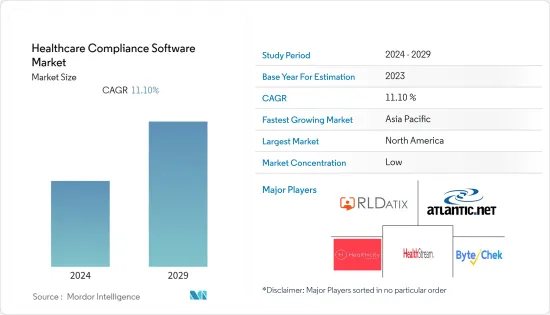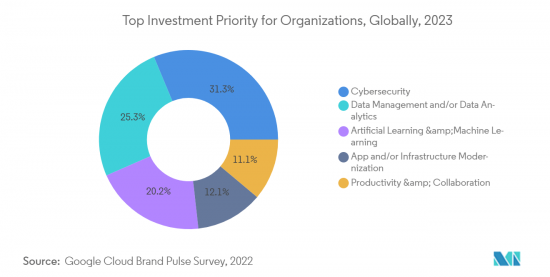PUBLISHER: Mordor Intelligence | PRODUCT CODE: 1408254

PUBLISHER: Mordor Intelligence | PRODUCT CODE: 1408254
Healthcare Compliance Software - Market Share Analysis, Industry Trends & Statistics, Growth Forecasts 2024 - 2029

The healthcare compliance software market is expected to grow at a significant CAGR of 11.1% during the forecast period.
The COVID-19 pandemic had a significant impact on the healthcare compliance software market. There was a surge in the adoption of healthcare compliance software by many healthcare organizations and hospitals due to social distancing and remote work. The pandemic also led to updates and changes in healthcare guidelines and regulations. Besides, on-site audits and inspections were difficult during the pandemic with restrictions on physical interactions. Hence, many organizations incorporated remote auditing. For instance, in response to an emergency, the Italian Accreditation Body, Accredia, rapidly implemented remote auditing through the issuance of Technical Circular DC N 06/2020 of March 7, 2020, and the subsequent supplementation with Technical Circular DC N 08/2020 of March 19, 2020. Thus, the compliance software facilitated remote auditing and assisted healthcare organizations to stay informed and revise their practices. Hence, the COVID-19 pandemic has boosted the market growth.
The shift from manual healthcare compliance methods to automated compliance software, and the growing volume of healthcare data, are the key factors driving the growth of the healthcare compliance market. For instance, according to the report updated by International Data Corporation (IDC), around 175 Zettabytes of data is likely to be generated across the globe till 2025 by the healthcare industry as compared to 33 Zettabytes in 2018. This is fueled by data-aggregating projects in the healthcare industry, such as biobank collections, electronic health records made by public and commercial healthcare providers, and data from companies that manufacture medical devices, operate social media platforms, and construct data platforms. Hence, such factors are likely to increase the demand for the healthcare compliance software market over the forecast period.
However, the growing adoption of technology to automate many aspects of the compliance monitoring process, such as data collection, analysis, reporting, and training staff is also a major contributor to the market growth. Technology can enhance the precision and efficiency of compliance monitoring thereby reducing the risk of human errors. It can also help organizations analyze large amounts of data, which can help identify areas of non-compliance and take corrective actions. Thus, due to the above-mentioned factors, the healthcare compliance software market is expected to increase during the study period.
However, the lack of awareness and limited IT resources among specialty clinics, and high implementation costs are likely to hinder market growth over the forecast period.
Healthcare Compliance Software Market Trends
Cloud-Based Segment Holds Significant Share in the Market During the Forecast Period
The cloud-based segment is expected to witness significant growth in the healthcare compliance software market over the forecast period. The key factor contributing to the growth of the segment is cost-effectiveness or subscription-based pricing model, and increased security and scalability. Besides, favorable government support is also contributing to market growth. For instance, the US Health Insurance Portability and Accountability Act (HIPAA), the European General Data Protection Regulation (GDPR), and the industry-standard CSF HITRUST Alliance all promote and regulate the protection of customers' personal information in online services. SaaS solutions and public cloud software are increasingly used to build HIPAA security programs and manage infrastructure without relying on on-premises data center experts and servers owing to their rapid deployment, scalability of workloads, applications, and affordable pricing. Thus, the adoption of cloud-based software by hospitals, and healthcare organizations would strengthen segment growth.
Additionally, the launch of new products in the segment will further drive market growth. For instance, in January 2023, CenTrak announced the launch of WorkflowRT, a scalable, cloud-based platform that automates workflow and communications to reduce the load of manual paperwork essential throughout each stage of clinical care. It allows organizations to track key patient flow indicators through the platform's integrated reporting in order to identify abnormalities or bottlenecks. Healthcare institutions have shown a decrease in patient wait times, an increase in care time with patients, and higher levels of satisfaction among patients and staff by leveraging historical measurements to support process improvements. Thus, the factors mentioned above are expected to propel the segment's growth over the forecast period.

North America Holds the Largest Market Share of the Healthcare Compliance Software Market
North America is expected to dominate the healthcare compliance software market over the forecast period. Among the other countries in the region, the United States is leading the market due to the rising incidents of cyber-attacks and data breaches, growing adoption of cloud-based solutions, increasing adoption of technology-driven solutions, and digitalization.
The increasing incidents of data breaches and cyber-attacks are contributing to market growth. For instance, as per the Office for Civil Rights (OCR) of the United States government reports, healthcare organizations reported 145 data breaches in the first quarter of 2023. However, in 2022, there were 707 reported incidents of data breaches, resulting in the theft of 51.9 million records. The most prevalent forms of healthcare data breaches in 2022 were hacking and IT incidents (555), unauthorized access or disclosure (113), physical theft (35), and improper record disposal (4). In addition, over the previous five years, the OCR imposed USD 65,658,440 in HIPAA fines. This includes USD 2,170,140 in 2022, with the largest penalty issued to Oklahoma State University's Center for Health Services, which had to pay USD 875,000 after criminal hackers penetrated its server. Such cases of cyber-attacks & data breaches are likely to drive the demand for healthcare compliance software which in turn is expected to boost the market growth.
Furthermore, the growing adoption of digital transformation in healthcare and cloud-based solutions also contributes to market growth. For instance, a 2023 article reported a study published by Duplo Cloud, the pioneer in the field of DevOps automation and compliance which conducted a survey among IT professionals to understand the adoption of cloud computing software in the healthcare industry. It reported that hospitals and Medicare/Medicaid organizations had the highest adoption rates of cloud infrastructure, at 91% and 90%, respectively, among the many types of healthcare organizations. The lowest levels of adoption were observed in dental offices (23%), and doctor's offices (37%). Thus, the high adoption rate by healthcare firms is likely to drive the healthcare compliance software market in the region over the forecast period.
Additionally, the presence of several key players and their focus on various strategies such as mergers & acquisitions, partnerships, product launches, and collaboration are also contributing to the market growth in the region. For instance, Panacea Healthcare Solutions acquired US-based healthcare software firm Holliday & Associates in August 2022. With this acquisition, the company can reach 600+ hospitals, medical practices, accountable care organizations, and health systems as clients. Also, the clients of the acquirer benefit from this acquisition as they have access to an extensive range of software solutions from a single provider. Thus, such acquisitions would strengthen the demand for software services which, in turn, is anticipated to boost the healthcare compliance software market.
Therefore, due to the factors mentioned above, the healthcare compliance software market is expected to grow in the region over the forecast period.
Healthcare Compliance Software Industry Overview
The healthcare compliance software market is moderately fragmented. Some key market players are Healthicity, LLC, RLDatix, Compliancy Group LLC, HealthStream, and Atlantic.Net. These players are focusing on strategies such as mergers and acquisitions, partnerships, and technological collaboration to expand their product portfolio and business footprint. Besides, many companies are forming agreements and looking for funding to accelerate their growth trajectories through partnership development and product expansion.
Additional Benefits:
- The market estimate (ME) sheet in Excel format
- 3 months of analyst support
TABLE OF CONTENTS
1 INTRODUCTION
- 1.1 Study Assumptions and Market Definition
- 1.2 Scope of the Study
2 RESEARCH METHODOLOGY
3 EXECUTIVE SUMMARY
4 MARKET DYNAMICS
- 4.1 Market Overview
- 4.2 Market Drivers
- 4.2.1 A Shift to Digital Data Storage By Healthcare Providers
- 4.2.2 Shift from Manual Healthcare Compliance Methods to Automated Compliance Software
- 4.2.3 Emphasis on Patient-Centered Care
- 4.3 Market Restraints
- 4.3.1 Lack of Awareness & Limited IT Resources among Specialty Clinics
- 4.3.2 High Implementation Costs
- 4.4 Porter's Five Force Analysis
- 4.4.1 Threat of New Entrants
- 4.4.2 Bargaining Power of Buyers/Consumers
- 4.4.3 Bargaining Power of Suppliers
- 4.4.4 Threat of Substitute Products
- 4.4.5 Intensity of Competitive Rivalry
5 MARKET SEGMENTATION (Market Size by Value - USD million)
- 5.1 By Product Type
- 5.1.1 On-Premise
- 5.1.2 Cloud-Based
- 5.1.3 Web-Based
- 5.2 By Category
- 5.2.1 Policy and Procedure Management
- 5.2.2 Auditing Tools
- 5.2.3 Training Management and Tracking
- 5.2.4 Medical Billing and Coding
- 5.2.5 License, Certificate, and Contract Tracking
- 5.2.6 Incident Management
- 5.2.7 Accreditation Management
- 5.2.8 Other Category
- 5.3 By End User
- 5.3.1 Hospitals
- 5.3.2 Specialty Clinics
- 5.3.3 Other End Users
- 5.4 Geography
- 5.4.1 North America
- 5.4.1.1 United States
- 5.4.1.2 Canada
- 5.4.1.3 Mexico
- 5.4.2 Europe
- 5.4.2.1 Germany
- 5.4.2.2 United Kingdom
- 5.4.2.3 France
- 5.4.2.4 Italy
- 5.4.2.5 Spain
- 5.4.2.6 Rest of Europe
- 5.4.3 Asia-Pacific
- 5.4.3.1 China
- 5.4.3.2 Japan
- 5.4.3.3 India
- 5.4.3.4 Australia
- 5.4.3.5 South Korea
- 5.4.3.6 Rest of Asia-Pacific
- 5.4.4 Middle East and Africa
- 5.4.4.1 GCC
- 5.4.4.2 South Africa
- 5.4.4.3 Rest of Middle East and Africa
- 5.4.5 South America
- 5.4.5.1 Brazil
- 5.4.5.2 Argentina
- 5.4.5.3 Rest of South America
- 5.4.1 North America
6 COMPETITIVE LANDSCAPE
- 6.1 Company Profiles
- 6.1.1 Healthicity, LLC
- 6.1.2 RLDatix
- 6.1.3 Compliancy Group LLC
- 6.1.4 HealthStream
- 6.1.5 Atlantic.Net
- 6.1.6 ByteChek, Inc.
- 6.1.7 Accountable HQ, Inc.
- 6.1.8 Complinity Technologies Private Limited
- 6.1.9 Radar Healthcare
- 6.1.10 ConvergePoint Inc.
- 6.1.11 Beacon Healthcare Systems
- 6.1.12 Sprinto
7 MARKET OPPORTUNITIES AND FUTURE TRENDS




